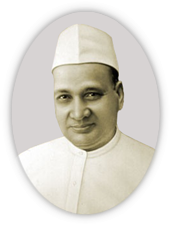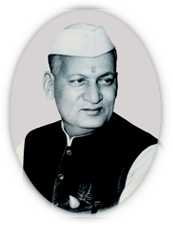
Jamnalal Bajaj was the third son of Kaniram and Birdibai, he was born in a village named Kashi Ka Bas, near Sikar. He was later adopted as a grandson by Seth Bachhraj and his wife Sadibai Bachhraj, a rich Rajasthani merchant couple of Wardha. Seth Bachhraj was a distant relative on his father's side, and was a well- known and respected trader in the British Raj. Upon coming of age, under the guidance of Seth Bachhraj, Jamnalal got involved in the family business of his grandfather. During this period he acquired the know-how of being a tradesman—keeping strict accounts and buying and selling commodities— excelling in his work by the time Seth Bachhraj died. In 1926 he founded what would become the Bajaj group of industries.

Kamalnayan Bajaj, the eldest son of Jamnalal Bajaj, started shouldering family responsibilities from an early age. After completing his education in Cambridge, University in England, Kamalnayan returned to India to assist his father Jamnalal, both in business and in social service. During India's freedom struggle, Kamalnayan interestingly chose not to court arrest. His purpose was to keep himself free to help those actively engaged in the freedom movement. Keenly conscious of the legacy of his reputed family that he had to carry forward, Kamalnayan once wrote to his father, that "It is no joke to be the son of a big man.
" Kamalnayan was a man of strict principles, which he never swerved from. He had earmarked a large portion of the income from his family business for public causes and social service programmes, the mantle of all of which he had inherited from his father. He always had a sense of a larger social mission, transcending the dictates of business and the bottom line. An astute businessman, Kamalnayan envisaged immense potential in India for manufactured textiles. But he did not pursue the profit in that business because of the firm commitment of the Bajaj family to khadi, inspired by Mahatma Gandhi. Clearly expounding his philosophy and his perspective, Kamalnayan observed, "The various industries I am connected with should generate profit. But if any move on our part goes against national interests, I would condemn it and would not be party to it, even if it meant a loss in the bargain." Every new business venture that Kamalnayan got into, eloquently testified to his legendary business acumen. With tremendous foresight and a spirit of zestful enterprise, Kamalnayan acquired ailing industrial units and then miraculously turned them around. He went on to expand the business by branching into manufacture of scooter, three-wheeler, cement, alloy casting and electricals. In 1954, Kamalnayan took over active management of the Bajaj Group companies. Besides being an insightful businessman, Kamalnayan was also a philanthropist driven by the passion for serving society at large. He was elected thrice as a member of the Lok Sabha in between 1957–1971 from Wardha constituency in Maharashtra. Kamalnayan Bajaj passed away in May 1972 at the age of 57

Ram Krishna Bajaj, the younger son of Jamnalal, took over after the demise of his elder brother Kamalnayan Bajaj in 1972. In addition to shouldering business responsibilities, Ram Krishna's energies were largely directed towards the social service and social welfare programmes of the Bajaj Group. He was of the firm conviction that he could make an impactful and meaningful contribution to the community through social work.
Ram Krishna had a flair and panache for working with youth. He was elected as the Chairman of World Assembly for Youth (India) in 1961. He also held the office of the Managing Trustee of the Indian Youth Centre Trust, which conceived and created the Vishwa Yuvak Kendra in 1968, a trail-blazing organization in youth development.

The first step in the acquisition of wisdom is silence, the second listening, the third memory, the fourth practices,

Knowledge and understanding are life's faithful companions, who will never prove untrue to you. As knowledge is your crown ....